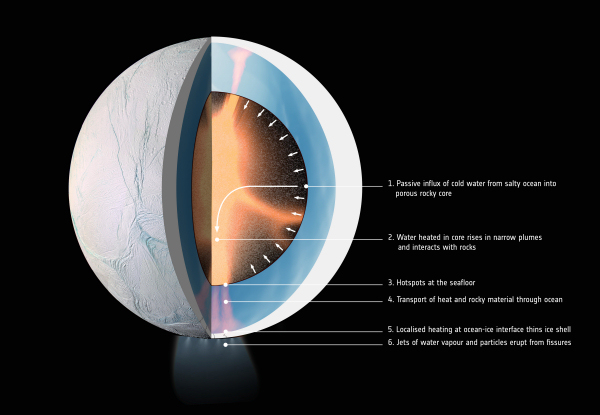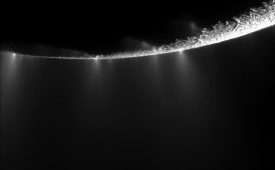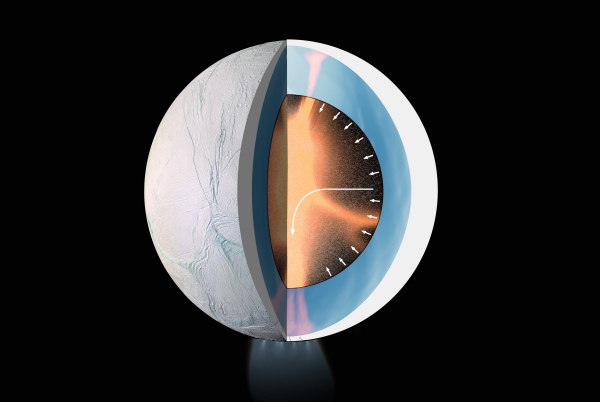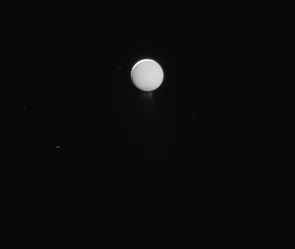Heating ocean moon Enceladus for billions of years
6 November 2017
Enough heat to power hydrothermal activity inside Saturn's ocean moon Enceladus for billions of years could be generated through tidal friction if the moon has a highly porous core, a new study finds, working in favour of the moon as a potentially habitable world. |
| Enceladus interior. Credits: Surface: NASA/JPL-Caltech/Space Science Institute; interior: LPG-CNRS/U. Nantes/U. Angers. Graphic composition: ESA |
A paper published in Nature Astronomy today presents the first concept that explains the key characteristics of 500 km-diameter Enceladus as observed by the international Cassini spacecraft over the course of its mission, which concluded in September.
This includes a global salty ocean below an ice shell with an average thickness of 20–25 km, thinning to just 1–5 km over the south polar region. There, jets of water vapour and icy grains are launched through fissures in the ice. The composition of the ejected material measured by Cassini included salts and silica dust, suggesting they form through hot water – at least 90°C – interacting with rock in the porous core.
 |
| Enceladus plumes. Credit: NASA/JPL/Space Science Institute |
These observations require a huge source of heat, about 100 times more than is expected to be generated by the natural decay of radioactive elements in rocks in its core, as well as a means of focusing activity at the south pole.
The tidal effect from Saturn is thought to be at the origin of the eruptions deforming the icy shell by push-pull motions as the moon follows an elliptical path around the giant planet. But the energy produced by tidal friction in the ice, by itself, would be too weak to counterbalance the heat loss seen from the ocean – the globe would freeze within 30 million years.
As Cassini has shown, the moon is clearly still extremely active, suggesting something else is happening.
"Where Enceladus gets the sustained power to remain active has always been a bit of mystery, but we've now considered in greater detail how the structure and composition of the moon's rocky core could play a key role in generating the necessary energy," says lead author Gaël Choblet from the University of Nantes in France.
In the new simulations the core is made of unconsolidated, easily deformable, porous rock that water can easily permeate. As such, cool liquid water from the ocean can seep into the core and gradually heat up through tidal friction between sliding rock fragments, as it gets deeper.
 |
| Enceladus interior. Credits: Surface: NASA/JPL-Caltech/Space Science Institute; interior: LPG-CNRS/U. Nantes/U. Angers. Graphic composition: ESA |
Water circulates in the core and then rises because it is hotter than the surroundings. This process ultimately transfers heat to the base of the ocean in narrow plumes where it interacts strongly with the rocks. At the seafloor, these plumes vent into the cooler ocean.
One seafloor hotspot alone is predicted to release as much as 5 GW of energy, roughly corresponding to the annual geothermal power consumed in Iceland.
 |
| Last Enceladus plume observation. Credit: NASA/JPL-Caltech/Space Science Institute |
Such seafloor hotspots generate ocean plumes rising at a few centimetres per second. Not only do the plumes result in strong melting of the ice crust above, but they can also carry small particles from the seafloor, over weeks to months, which are then released into space by the icy jets.
Moreover, the authors' computer models show that most water should be expelled from the moon's polar regions, with a runaway process leading to hot spots in localised areas, and thus a thinner ice shell directly above, consistent with what was inferred from Cassini.
"Our simulations can simultaneously explain the existence of an ocean at a global scale due to large-scale heat transport between the deep interior and the ice shell, and the concentration of activity in a relatively narrow region around the south pole, thus explaining the main features observed by Cassini," says co-author Gabriel Tobie, also from the University of Nantes.
The scientists say that the efficient rock-water interactions in a porous core massaged by tidal friction could generate up to 30 GW of heat over tens of millions to billions of years.
"Future missions capable of analysing the organic molecules in the Enceladus plume with a higher accuracy than Cassini would be able to tell us if sustained hydrothermal conditions could have allowed life to emerge," says Nicolas Altobelli, ESA's Cassini project scientist.
A future mission equipped with ice-penetrating radar would also be able to constrain the ice thickness, and additional flybys – or an orbiting craft – would improve models of the interior, further verifying the presence of active hydrothermal plumes.
"We'll be flying next-generation instruments, including ground-penetrating radar, to Jupiter's ocean moons in the next decade with ESA's JUICE mission, which is specifically tasked with trying to understand the potential habitability of ocean worlds in the outer Solar System," adds Nicolas.
Notes for Editors
"Powering prolonged hydrothermal activity inside Enceladus," by G. Choblet et al. is published in Nature Astronomy, 6 November 2017.
The Cassini-Huygens mission is a cooperative project of NASA, ESA and Italy's ASI space agency.
For further information, please contact:
Gaël Choblet
Université de Nantes, France
Email: Gael.Choblet![]() univ-nantes.fr
univ-nantes.fr
Gabriel Tobie
Université de Nantes, France
Email: gabriel.tobie![]() univ-nantes.fr
univ-nantes.fr
Nicolas Altobelli
ESA Cassini-Huygens Project Scientist
Tel: +34 91 813 1201
Email: nicolas.altobelli![]() esa.int
esa.int
Markus Bauer
ESA Science Communication Officer
Tel: +31 71 565 6799
Mob: +31 61 594 3 954
Email: markus.bauer![]() esa.int
esa.int




